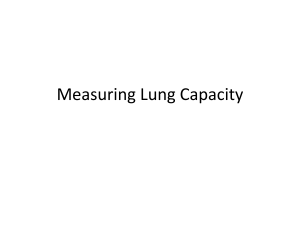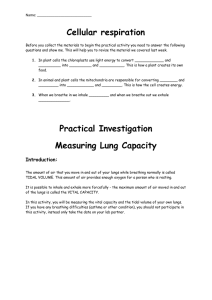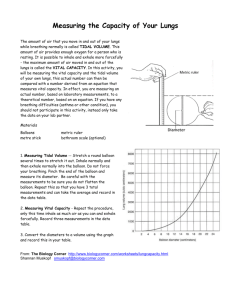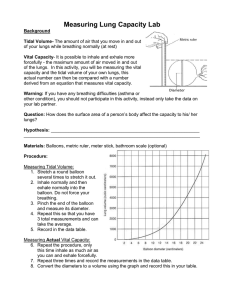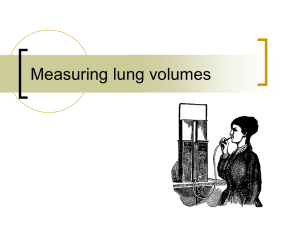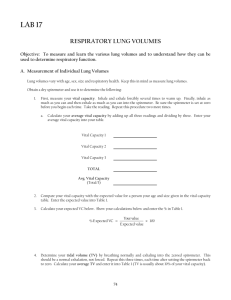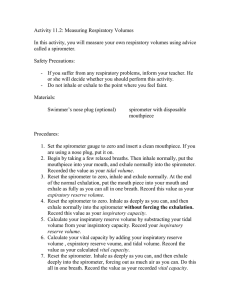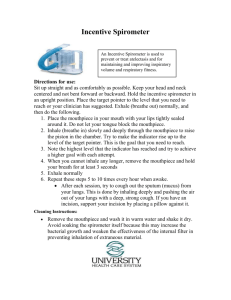Lung Capacity Lab - IB-Biology
advertisement
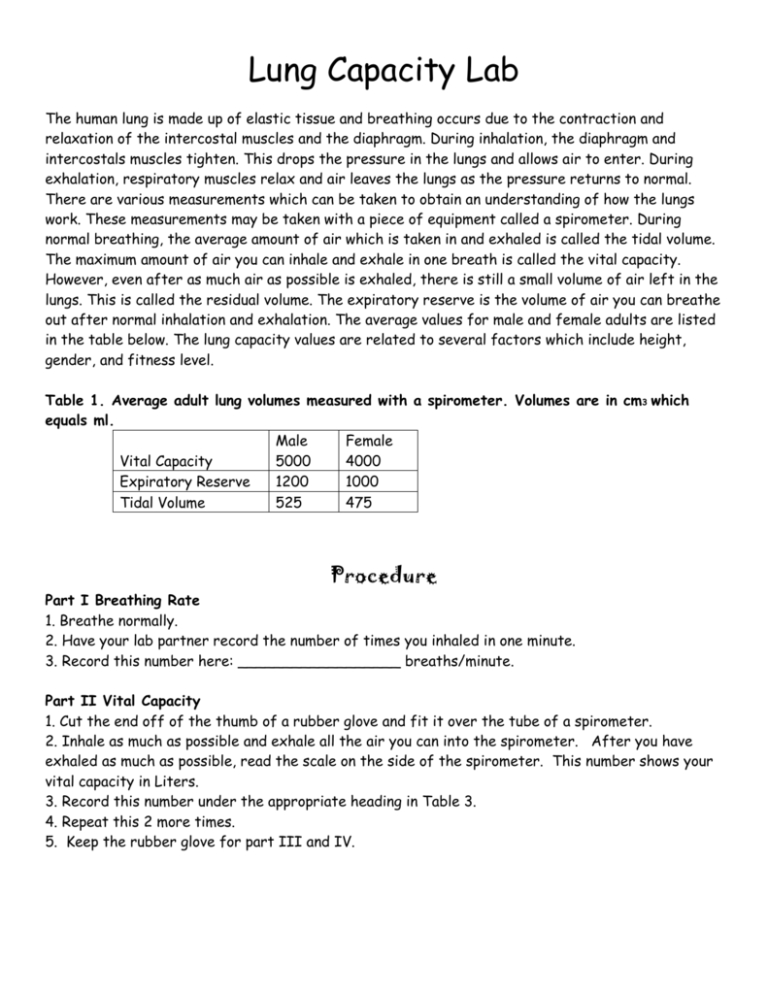
Lung Capacity Lab The human lung is made up of elastic tissue and breathing occurs due to the contraction and relaxation of the intercostal muscles and the diaphragm. During inhalation, the diaphragm and intercostals muscles tighten. This drops the pressure in the lungs and allows air to enter. During exhalation, respiratory muscles relax and air leaves the lungs as the pressure returns to normal. There are various measurements which can be taken to obtain an understanding of how the lungs work. These measurements may be taken with a piece of equipment called a spirometer. During normal breathing, the average amount of air which is taken in and exhaled is called the tidal volume. The maximum amount of air you can inhale and exhale in one breath is called the vital capacity. However, even after as much air as possible is exhaled, there is still a small volume of air left in the lungs. This is called the residual volume. The expiratory reserve is the volume of air you can breathe out after normal inhalation and exhalation. The average values for male and female adults are listed in the table below. The lung capacity values are related to several factors which include height, gender, and fitness level. Table 1. Average adult lung volumes measured with a spirometer. Volumes are in cm3 which equals ml. Male Female Vital Capacity 5000 4000 Expiratory Reserve 1200 1000 Tidal Volume 525 475 Procedure Part I Breathing Rate 1. Breathe normally. 2. Have your lab partner record the number of times you inhaled in one minute. 3. Record this number here: __________________ breaths/minute. Part II Vital Capacity 1. Cut the end off of the thumb of a rubber glove and fit it over the tube of a spirometer. 2. Inhale as much as possible and exhale all the air you can into the spirometer. After you have exhaled as much as possible, read the scale on the side of the spirometer. This number shows your vital capacity in Liters. 3. Record this number under the appropriate heading in Table 3. 4. Repeat this 2 more times. 5. Keep the rubber glove for part III and IV. Part III Expiratory Reserve 1. Breathe normally. 2. After you exhale normally, force all of the remaining air in your lungs into the spirometer. 3. Record this number under the appropriate heading in Table 3. 4. Repeat this 2 more times. Part IV Tidal Volume 1. You should now be fully aware of your normal breathing. Continue to breathe normally. 2. After inhaling a regular amount of air, exhale the amount of air you normally do into the spirometer. Do NOT force more air out than you think is normal. 3. Record this number under the appropriate heading in Table 3. 4. Repeat this 2 more times Part V Calculation of Expected Vital Capacity 1. Record your height in centimeters in Table 3. Multiply your height in inches by 2.54 to get your height in centimeters. 2. Fill in your factor in Table 3 with the appropriate factor listed below. 3. Calculate your expected vital capacity by multiplying height by the factor you get in table 2 using the following formula. Height (cm) x Factor from table 2 = Calculated Vital Capacity Table 2. Factor values according to gender and fitness levels. Females Low fitness level Medium fitness level High fitness level 20 21 22 Males Low fitness level 25 Medium fitness level 27 High fitness level 29 My Calculated Vital Capacity is: Table 3: Lung Volume in Liters Trial # Vital Capacity 1 2 3 Average Expiratory Reserve Tidal Volume Conclusion Questions (you can use the power point print out I gave you Tuesday or the book.) 1. Describe the mechanism of inhalation and exhalation. 2. Why do you think there is a residual volume of air remaining in the lungs even after you force as much out as possible? 3. Did your experimental volumes (Table 3) match those indicated in Table 1? Give several specific reason why there may be an error. 4. How does your experimental vital capacity (Table 3) compare with the calculated one in part V? Give a specific reason why there might be an error. 5. How much air would you inhale and exhale in 1 minute? 6. How would an asthma attack affect the tidal volume? 7. Explain the difference between ventilation, gas exchange, and cellular respiration.
